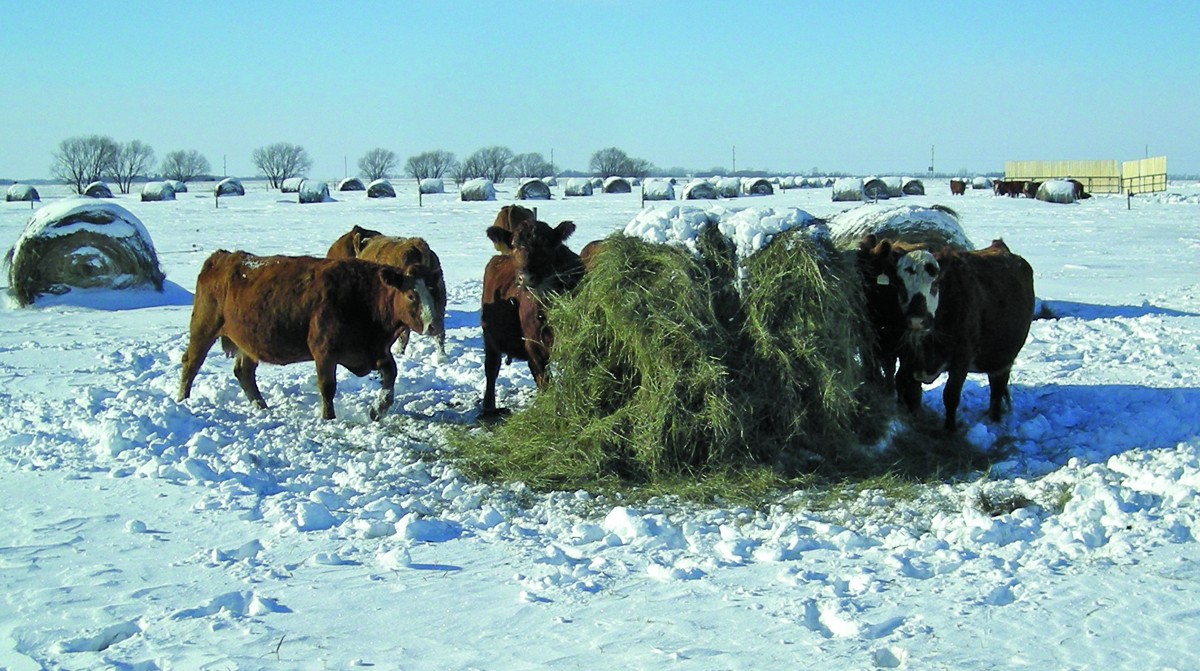
Cattle Country: Intermediate wheatgrass – potential as a rescue hay crop
The following article was written by P. LeHeiget, E.J. McGeough and D.J. Cattani, University of Manitoba. It was originally published in Cattle Country in November 2022.
In recent years, significant drought in western Canada has been a major challenge for not only grazed pasture but also for the production of hay for overwintering of the cow herd. Feed shortages (both in quality and quantity) has been occurring with increasing frequency over the last decade and represent a critical challenge for producers.
At the University of Manitoba, researchers are evaluating intermediate wheatgrass (IWG) as a perennial grain crop with dual purpose potential (within a single season) not only for food but also for cattle feed. This work builds on the perennial grain breeding program of Dr. Doug Cattani which began developing a perennial grain type IWG under western Canadian growing conditions in 2011. Intermediate wheatgrass is a deep-rooted, relatively drought tolerant grass, introduced to western Canada in response to the issues of the 1930’s.
A dual-purpose forage can enhance sustainable crop/livestock intensification in a number of ways, including harvesting a cash food grain crop and concurrently providing much-needed high quality feed for cattle in late fall/early winter, when the quality of the typically offered stockpiled forages is generally low. A single planting with multiple years of grain production offers several other benefits such as providing valuable habitat for wildlife, including nesting waterfowl and songbirds, greater water use efficiency, nutrient management, and soil protection.
What did we do?
As part of a larger project evaluating the yield and nutritive value of IWG regrowth post-grain harvest as grazed late fall/early winter feed for growing beef cattle, we also evaluated if IWG could be used as a hay crop in the event of summer drought/crop failure when producers may need to abandon grain harvest to provide additional cattle feed.
This large scale (45 ac) study was carried out at the University of Manitoba’s Glenlea Research Station, with the pastures established in 2020 and field measurements taken in 2021 when widespread drought conditions occurred throughout the province. The April 1-June 30 rainfall for the Glenlea site is 179 mm compared to 103 mm in 2021, of which 12 mm fell after all harvests were completed. The average daily temperatures in 2021 for June of 19.8℃ was about 2℃ above the long-term normal. Three treatments were evaluated: 1) IWG in a pure stand with no fertilizer post establishment, representing a low input system, 2) IWG (50%) + alsike clover (50%). Alsike clover naturally fixes nitrogen and has good water tolerance relative to alfalfa but is less aggressive which is important for mixed stand establishment. These were compared to a more traditional hay mix of 50% grass (tall fescue): 50% legume (alfalfa + cicer milkvetch).
Pastures were managed for weeds in 2020, with the IWG and grass/legume mix with the IWG sampled just before flowering in 2021 and the grass/legume mix harvested at 20% alfalfa bloom on June 15 to determine their yields and feeding value. No rain was received between the timings of the forage mixture (5 days earlier) and IWG harvests. No fertilizer was applied to any IWG plots prior to grain harvest 2021.
What did we find?
Our analysis showed that under drought conditions, the pure stand of IWG yielded, on average, 2.92 tonnes of dry matter (DM)/ac, with 10% crude protein (CP) and 57% total digestible nutrients (TDN). The IWG/clover mix had a lower yield of 2.41 tonnes of DM/ac, but higher feed quality at 12% CP and 59% TDN. Comparing the IWG to the grass:legume mix, the tall fescue/alfalfa/cicer milk vetch had the lowest yield overall at 1.52 tonnes of DM/ac, but had the highest feed quality at 19% CP and 63% TDN. IWG produced 20% and 90% greater yields than the alsike clover mixture and the potential hay crop, respectively.
Additional to the evaluation of IWG as a hay potential hay crop, the researchers subsequently harvested the grain from the crop in early August. Although the grain was destined for food production, the research team evaluated the feed quality of the straw post grain harvest as an additional source of cattle feed. As expected, the feed quality of the straw was much lower than the hay, however it ranged from 5.3 – 7% CP, with TDN ranging from 50-52%, higher than may be seen with conventional annual crop straw. Although not a high-quality feed, this straw may be an important supplementary feed source in times of feed shortage.
Take home message
When faced with drought conditions, IWG offered a 90% greater yield than a traditional grass/legume mix. However, higher feed value was observed with the grass/legume, thus consideration of the tradeoff between yield and quality for hay is essential. Nevertheless, this study showed that intermediate wheatgrass, alone or in combination with a legume, offers a potential avenue to supplement hay supplies in times of limited forage growth. Coupled with its ability to provide a cash crop and potential for late fall/early winter grazing for beef cattle, this dual purpose crop offers diverse options for cattle producers.






